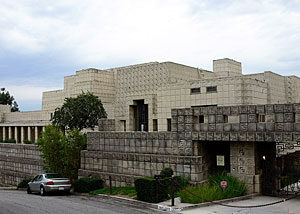A seller’s market, this is not. The Frank Lloyd Wright-designed Ennis House is still for sale nearly two months after it was listed for $15 million by the nonprofit organization that owns it. Despite ample publicity, the house has not elicited a single bid.

Built in 1924 for Charles and Mabel Ennis on a hilltop in the Los Feliz neighborhood of Los Angeles, it is the largest of Wright’s four “textile-block” styled houses in Southern California. Over the years, the 6,000-square-foot home, whose design was inspired by ancient Mayan temples, has acquired quite the list of historical and cultural accolades, earning a spot on the National Register of Historic Places and being declared a California State Landmark and a Cultural Heritage Monument. It has also served as a popular location for movies, music videos, and photo shoots.
Hilton & Hyland Realtors is the luxury-market agency that is working with international service-provider Christie’s Great Estates to sell the landmark. The $15 million asking price does not cover the $6 million projected cost for repairs on the 85-year-old home.
The Ennis House Foundation, formerly the Trust for the Preservation of Cultural Heritage, has owned the house since 1980. Along with two other nonprofits, the foundation has spent a reported $6.5 million since 2005 on repairs because of a 1994 earthquake and additional rain damage. Both the National Trust for Historic Preservation and the World Monuments Fund have listed the house on their lists of endangered sites. Requiring more stewardship than it was able to provide, the foundation put the dwelling on the market in mid-June with a “conservation easement” to prevent demolition and to guide future renovation.
So far, the real estate agents say there’s been considerable interest in the Ennis House, even internationally. “We’ve had a lot of really qualified buyers looking at it,” says Aaron Kirman, executive director of the architecture division of the agency. “But we’re not in a huge rush here; we’re looking for the right person, the right fit for this house—someone who understands the architectural significance and is excited to complete the restoration.”
Kirman suspects that no offers have been made due to a lack of specific information about the conservation easement and past renovations. Recently, those details have become available, he says, and with this will come more serious buyers willing to take on this “labor of love.”
In a 1924 letter to Mr. & Mrs. Charles Ennis regarding the house’s design, Frank Lloyd Wright boasted that “the final result is going to stand on that hill a hundred years or more.” To hit the century-mark, this “temple on the hill” needs a restoration-minded benefactor to save it from becoming more like the ancient ruins that once inspired Wright.


Post a comment to this article
Report Abusive Comment